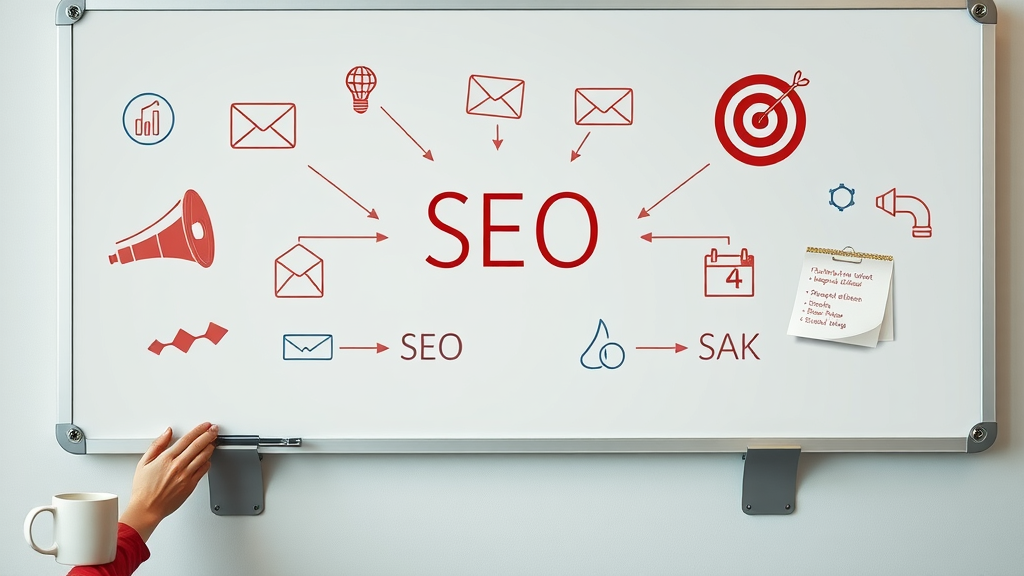Did you know? Over 90% of consumers use the internet to discover local businesses—and nearly 80% will decide to work with a business based on their digital reputation alone. In today’s hyper-connected world, digital marketing for small business isn’t just an option; it’s the key to unlocking fast, measurable growth. If you’re ready to dominate your local market and win more customers online, this guide will show you exactly how to get there.
Turbocharge Business Success: Why Digital Marketing for Small Business Matters More Than Ever
In a landscape where budgets are tight and competition is fierce, small businesses that embrace digital marketing gain a significant edge. With nearly every potential customer searching, shopping, or researching online, your online presence has the power to make or break your brand. Online marketing enables you to reach your exact target audience at the right moments—whether they're searching Google for your products or browsing social media for inspiration. Investing in digital marketing for small business means ensuring that your brand is front and center when customers are ready to buy.
Practical examples abound: A local bakery might use social media posts to promote daily specials. A home services business could boost Google visibility through search engine optimization , generating calls from nearby customers each week. With a modest budget, even a startup can run retargeting Google Ad campaigns to re-engage recent website visitors and turn interest into sales. The bottom line: Digital strategies put power back in the hands of the small business owner , delivering trackable, affordable, and scalable growth.

Did You Know? 78% of Small Businesses Now Invest in Digital Marketing
If you’re wondering whether digital marketing is really that widely adopted, consider this: 78% of small businesses now invest in at least one digital channel, be it search engine marketing , social media marketing , or email marketing . The businesses left behind risk invisibility in a world run by algorithms and online reviews.
"Without digital marketing, small businesses risk missing out on 70% of potential online customers." — Forbes
What Small Businesses Will Learn About Digital Marketing for Small Business
- How digital marketing for small business drives growth
- Key digital marketing strategies for small business
- Building a powerful online presence
- Cost-effective marketing tactics
- How to measure and optimize small business marketing efforts

Digital Marketing for Small Business: Essential Benefits and Core Principles
The Digital Advantage: Why Every Small Business Needs to Invest
Digital marketing gives small businesses a way to level the playing field with larger competitors. Traditional advertising can be cost-prohibitive, but with a smart digital marketing strategy , local businesses can capture attention, build trust, and convert customers faster and more efficiently. Lower costs, laser-focused targeting, and the ability to track every click and conversion mean that each dollar spent has greater impact and less waste compared to offline efforts.
Importantly, digital channels present a two-way street for communication. Social media platforms and email marketing enable direct interaction with customers, offering valuable feedback that can help shape your products or services . Every piece of data you collect—from website visits to e-newsletter open rates—provides actionable insights that inform smarter marketing strategies , allowing for continuous improvement and adaptation to changes in consumer behavior.
Understanding Digital Marketing and Its Role in Small Businesses
At its core, digital marketing is the use of online channels to promote your business and connect with your audience. For a small business, this means using tactics like search engine optimization (SEO) to climb search rankings, leveraging social media to foster community, crafting email newsletters to nurture customer loyalty, and deploying paid ads for quick wins. The real power lies in integration—when all these efforts work in conjunction, they amplify your results, bring in more leads, and increase your revenue.
Digital marketing also offers the agility to test new ideas, adapt quickly, and get measurable results. Unlike print or TV ads, you can refine your message, audience targeting, or creative in real-time. This makes your marketing efforts both cost-effective and agile—hallmarks of success for today’s small businesses .
| Marketing Strategy | ROI Potential | Complexity |
|---|---|---|
| Search Engine Optimization | High | Medium |
| Social Media Marketing | Moderate | Low |
| Email Marketing | Very High | Low |
| Paid Google Ads | High | High |
Establishing Your Online Presence: The First Step in Digital Marketing for Small Business
Crafting an Effective Small Business Profile for Digital Success
Before you can capture new customers, you need a business profile that stands out wherever potential clients search for you. Start by making sure your information is consistent across platforms—your business name, address, phone number, hours, and website should look identical on your website, social media platforms, and local directories. Consistency bolsters search engine trust and ensures you’re found in every relevant search result. In addition, include professional photos, a concise description of what makes your business unique, and relevant keywords that align with your products or services .
Take the extra step to encourage existing customers to leave positive reviews and ratings on platforms like Google and Yelp. These real-world endorsements help boost your credibility and influence new customers’ decisions. Remember, your business profile often creates the first impression—make it memorable, accurate, and customer-centric.

Building a Conversion-Driven Business Website
Your website is more than an online brochure—it’s the foundation of your online presence and a powerful marketing tool. To turn visitors into customers, your site must load fast, display beautifully on mobile devices, and feature clear calls-to-action (CTAs) such as “Book Now,” “Shop,” or “Contact Us.” Elements like customer testimonials, detailed service descriptions, and engaging visuals help build trust and guide visitors down the path to purchase. Don’t forget simple navigation and visible business contact details—these small details signal professionalism and increase the likelihood of conversions.
If possible, integrate lead capture forms or instant messaging tools so you can collect leads and respond promptly. Use analytics tools from day one to monitor which pages people visit most or where they tend to exit. This constant measurement lets you refine your messaging and web design for ever-improving results.
Optimizing for Local Search Engine Visibility
A huge part of digital marketing for small business is dominating local search results . Implementing smart tactics for search engine optimization (SEO) ensures your business appears when customers search for your products or services nearby. Use location-specific keywords in your website content, meta tags, and headings, and make sure your site is indexed by major search engines like Google.
Encourage happy customers to leave reviews and ensure your physical address matches exactly across the web. Join local business directories, which often rank highly in local searches, and regularly update your business hours and offerings. By continually refining your local SEO, you ensure new customers find you ahead of your competition.
Implementing Search Engine Optimization (SEO) Strategies
Effective engine optimization combines keyword research (to understand what your audience is searching for) with regular content creation—think blog posts, service pages, or FAQ sections that answer specific questions. Building high-quality backlinks from local news sites or business directories increases your site’s authority in the eyes of search engines . Regular site audits help eliminate technical errors and improve page speed. Together, these steps boost your visibility, ensuring your business lands at the top of critical search engine results.
Claiming and Perfecting Your Google Business Profile
No discussion about local digital marketing for small business is complete without the Google Business Profile (formerly Google My Business). Claiming your profile allows your business to appear in local maps, knowledge panels, and at the very top of Google search results. Fill out every field, add high-quality images, and use posts to highlight your latest offers. Regularly update your info and respond to reviews (both positive and negative) to foster trust and enhance your online presence .
Not only does this improve your SEO, but it also gives customers all the info they need at a glance—hours, contact, directions, and even posts or Q&A. The more active and complete your Google Business Profile, the higher your chance of being chosen over competitors just a click away.
Developing a Winning Digital Marketing Strategy for Small Business
Identifying Your Target Audience and Maximizing Reach
Every strong digital marketing strategy begins with a deep understanding of your target audience . For small businesses , this means going beyond broad demographics—consider ages, locations, interests, pain points, and the specific needs your business solves. Build customer personas to visualize your ideal customers and guide each marketing decision. Use website analytics, customer surveys, and social media insights to collect real data about who engages with your business and how.
Once you know your audience inside and out, tailor your messaging style, offers, and the platforms you use. For example, a boutique shop catering to millennials may focus on video content and Instagram, while a landscaping service might rely on Google and Facebook. The more precisely you define and reach your audience, the more effective every marketing dollar becomes.

Choosing the Right Marketing Strategies Based on Small Business Goals
Your digital marketing shouldn’t be scattershot; align your efforts with your business’s unique goals. Do you want to drive more website visits, capture emails, increase direct sales, or boost brand awareness? Each objective demands a different toolkit—SEO and Google Ads for high-intent traffic, social media for engagement and reputation building, and email marketing for retention and upselling. Factor in your budget, seasonality, and internal resources before committing to a plan.
Test a few tactics to find what resonates. For a service business, try paid lead generation ads and measure their impact. If you’re an e-commerce company, lean into Instagram and retargeting ads. Frequent evaluation lets you double down on successful channels and tweak or pause what’s not working.
"A strategic digital marketing approach allows small businesses to compete and even outperform larger competitors." — HubSpot
Maximizing Social Media for Small Business Growth
Selecting Effective Social Media Platforms for Your Business
With countless social media platforms , picking the right ones can feel daunting. The key is to go where your audience already spends time. Facebook is great for community engagement and local advertising, while Instagram is perfect for visually-driven brands. LinkedIn works well for B2B connections, and TikTok is growing fast for creative, younger audiences. Rather than spreading yourself thin, focus efforts on two to three platforms where you can maintain consistent, high-quality content.
Check out your competitors to see where engagement is happening, and dig into analytics to monitor which posts and platforms yield actual leads or sales. Optimize your social media marketing by scheduling regular posts, using hashtags strategically, and interacting directly with followers in comments or messages.
Creating Engaging Content and Building Brand Loyalty
Quality content turns passive viewers into loyal customers. Experiment with behind-the-scenes photos, how-to videos, live Q&A sessions, customer testimonials, and case studies that tell your brand story in an authentic way. Visual consistency—using brand colors, fonts, and logos—fosters recognition and trust. Invite customer participation through contests, challenges, or user-generated content campaigns.
Social media is less about broadcasting and more about community. Respond quickly to comments, thank reviewers, and spotlight your followers and their stories to nurture long-term brand loyalty. Tools like Canva or Buffer can help streamline content creation and scheduling, giving you more time to focus on core business operations.

Leveraging Influencer Marketing to Expand Reach
Influencer marketing is no longer reserved for global brands. Partner with local micro-influencers whose followers mirror your target audience . From featuring your product in a review post to hosting a giveaway, influencers lend credibility and help introduce your small business to qualified new customers faster. Choose partners who align with your values and verify that their followers actively engage with content, not just boost follower counts.
Start small: offer free samples, discount codes, or affiliate commissions to influencers in exchange for honest content about your products or services. Over time, these partnerships can lead to increased traffic, better brand recall, and more sales—all while building organic word-of-mouth in your community.
Email Marketing for Small Businesses: Building Customer Relationships
How to Grow and Utilize an Effective Email List
An email list remains one of the highest ROI assets for small businesses . Start by adding sign-up forms to your website, social media, and checkout pages. Sweeten the deal—a discount, a free download, or a giveaway entry encourages customers to join your list. Use segmentation to group subscribers by preferences, purchase history, or engagement level, ensuring your messages always feel relevant and personalized.
Protect your reputation by never purchasing email lists; always build organically with the explicit permission of your audience. Once you have your list, use it thoughtfully for nurturing leads, promoting new products or services, and requesting reviews that fuel your online reputation and rankings.

Crafting Email Marketing Campaigns that Deliver Results
Great email marketing balances value with persuasion. Craft subject lines that spark curiosity and keep content concise. Share helpful tips, announce special offers, or highlight testimonials and success stories to drive clicks. Personalize greetings and recommendations based on your email list data—personalization can dramatically increase open and conversion rates.
Experiment with automated drip sequences for welcoming new customers or re-engaging inactive subscribers. Always include a clear call-to-action and review key analytics like open rates, click-through rates, and unsubscribe rates to tune future campaigns.
Smart Paid Advertising Tactics: Google Ads, Remarketing, and More
Google Ad Campaigns: How to Maximize ROI for Small Businesses
Google Ad campaigns are a powerful shortcut to the top of search engine results, delivering instant exposure to people seeking your offerings. Set a fixed monthly budget and use tight targeting—location, age, interests—to maximize conversion rates and minimize waste. Write compelling ad copy and use ad extensions (site links, call buttons, reviews) to increase click-through. Regularly test different versions of your ads to see which headlines, images, or offers yield the best return on investment.
Monitor your Google Ad campaign metrics—clicks, conversions, cost per acquisition—and adjust bids or keywords as needed. Google’s built-in analytics simplify this process, ensuring you get the most possible leads for your marketing dollars. Don’t overlook the power of running ads during strategic periods like holidays or peak seasons for your industry.
Retargeting Ads: Re-Engage Past Visitors and Capture Leads
Most people need to encounter your business multiple times before making a purchase. Retargeting ads help you reconnect with website visitors who didn’t convert the first time. Platforms like Google, Facebook, and Instagram allow you to show custom ads to users who abandoned a cart, browsed a product page, or spent time on your site. This persistent presence nudges them back and significantly boosts conversion rates.
Retargeting is a cost-effective way to squeeze extra ROI out of your existing traffic, making it ideal for small businesses with limited budgets but high conversion goals.
| Ad Type | Best For | Approx. Budget |
|---|---|---|
| Google Search Ads | Local Traffic | $500+/mo |
| Facebook Ads | Brand Awareness | $300+/mo |
| Instagram Ads | Retail Products | $250+/mo |
Content Marketing Strategies: Driving Organic Growth for Small Businesses
Blogging, Videos, and Media Platforms: Content That Converts
Content marketing is about giving value first, earning trust over time. For small businesses , regular blog articles on FAQs, “how-to” guides, seasonal trends, and customer stories showcase your expertise and attract new search traffic. Video content—demos, behind-the-scenes, or customer success stories—performs exceptionally well on media platforms like YouTube, Instagram, and Facebook, expanding your audience far beyond your website.
Each piece of content should address a question or need your target customers have. Include relevant keywords and calls-to-action that drive readers to take the next step, whether that’s booking a free consult, downloading a guide, or making a purchase.

Developing a Content Calendar to Streamline Marketing Efforts
Consistency and planning are critical to content marketing success. Allocate time each month to brainstorm upcoming topics, set publishing dates, and assign roles. Use a content calendar spreadsheet or tools like Trello, Asana, or Google Calendar to visualize your plan. Map major seasonal promotions, product launches, and recurring blog features so you can prepare in advance rather than scramble at the last minute.
This proactive approach keeps your brand top-of-mind and helps maintain a steady flow of organic traffic to your site and social platforms—all while preventing marketing burnout.
Tracking, Analytics, and Measuring Marketing Efforts in Small Businesses
Key Metrics Every Small Business Should Track for Digital Marketing
Measuring your marketing efforts is as important as launching them. Crucial metrics include website traffic, sources of traffic (organic, paid, referral, social), conversion rates (sales, leads, sign-ups), cost per acquisition, email open/click rates, and social media engagement. Tools like Google Analytics, Facebook Insights, and email marketing dashboards provide granular data for continuous optimization.
Set monthly or quarterly goals for each channel. If a certain marketing strategy isn’t delivering, reassess: maybe your targeting is off, your landing page underwhelms, or your offer doesn’t resonate. Track micro-metrics too—like time on site, bounce rate, and top-performing content—to learn what excites and engages your audience.

Optimizing Campaigns Based on Data
Regular reporting is your roadmap to better ROI. Start by analyzing which campaigns generate the most conversions, lowest cost per lead, or highest engagement. Don’t be afraid to pause under-performing ads or content and shift your budget to what works. Test new ideas, A/B test messaging, and experiment with new platforms or strategies. Each small iteration sharpens your competitive advantage and delivers stronger results with less effort.
Ultimately, the businesses that win long-term are those who let the data—not guesses—guide their every step.
Marketing Budgeting for Small Businesses: Maximize Every Dollar
How to Allocate a Marketing Budget for Efficient Results
Every small business faces strict budget constraints, so make every dollar count. Start by setting marketing goals (brand awareness, leads, sales), then distribute funds across channels most likely to deliver. Prioritize high-ROI methods—SEO, email marketing, and social media—before committing to large ad spends. Monitor spend monthly, ensuring you’re not overspending on tactics that fail to move the needle. Keep a buffer for experiments or unexpected opportunities to scale what works.
Tools like Google’s Keyword Planner and Facebook Ad Manager offer budget estimations for campaigns, helping you predict costs versus expected results. Regular reviews ensure your marketing budget delivers measurable growth, not just speculative exposure.

Low-Budget Digital Marketing Hacks for Small Business Owners
Resourceful small business owners get creative: Collaborate with neighboring businesses for cross-promotions, start a referral program, repurpose existing content, or run limited-time social contests. Use free tools for graphic design (like Canva) and marketing automation (like Mailchimp). Leverage your personal and professional network to drum up reviews and word-of-mouth buzz. These “hacks” cost little but pay big dividends when implemented consistently.
"Don't let limited resources limit your vision — smarter spending beats bigger budgets for many small businesses." — Neil Patel
Case Studies: Digital Marketing for Small Business Success Stories
How Local Businesses Used Digital Marketing to Double Their Revenue
Consider a local bakery that launched a new website and began promoting daily specials on Facebook and Instagram, alongside a monthly email newsletter loaded with coupons. They saw online orders jump 120% in just six months—and customer reviews drove even more foot traffic. Or a plumbing company that optimized their Google Business Profile, invested in local Google Ads, and focused on collecting customer feedback. Their inbound calls doubled, and their average job size increased with higher-value leads coming in from search engines.

Creative Social Media Campaigns That Made a Difference
One pet store created a “Pet of the Week” contest on Instagram, encouraging customers to share photos for a prize. Engagement skyrocketed, and foot traffic picked up as a result. Meanwhile, a remodeling contractor used before-and-after project reels on Facebook, turning viewers into steady leads and building their reputation in the community. These creative, authentic campaigns turned small budgets into outsized, lasting business results.
Frequently Asked Questions About Digital Marketing for Small Business
How to do digital marketing for a small business?
Begin by building a robust online presence —create a professional website, claim your Google Business Profile , and establish active accounts on relevant social media platforms . Implement search engine optimization (SEO) to rank highly in local searches. Use email marketing to nurture leads and build repeat business. Consider small-scale paid ads for quick results, and always track your marketing efforts using analytics for ongoing improvement.
Step-by-Step Guide for Launching Digital Marketing for Small Business
- Audit your current online profiles and website.
- Define your target audience and business goals.
- Choose the best marketing channels (SEO, social media marketing , email marketing , or Google Ad campaigns).
- Develop a content or posting calendar.
- Launch campaigns and monitor analytics—adjust based on what works!
Is digital marketing worth it for small businesses?
Absolutely. Digital marketing offers unmatched reach, precise targeting, and measurable results—all crucial for small businesses with limited resources. Even modest budgets, when spent strategically, can produce significant growth, helping you attract, convert, and retain more customers than traditional media alone.
Analysis: Digital Marketing ROI for Small Businesses
The ROI for digital marketing far surpasses most traditional channels. For every $1 spent on email marketing , for example, the average return is $36. SEO and well-optimized ad campaigns create compounding returns as your online presence and reputation grow over time. Track your KPIs—leads, clicks, conversions—to ensure a consistently positive ROI and reinvest in what delivers the greatest results.
What are the 4 types of digital marketing?
The four main types of digital marketing for small businesses are: Search engine optimization (SEO) , social media marketing , content marketing (blogging, videos), and email marketing . Each can work alone but delivers maximum impact when combined within a cohesive digital marketing strategy .
Breakdown of Key Digital Marketing Types for Small Businesses
- SEO: Boosts visibility in search results for relevant terms.
- Social Media Marketing: Engages and grows your audience on platforms like Facebook and Instagram.
- Content Marketing: Attracts new leads through high-value information and storytelling.
- Email Marketing: Builds loyal customer relationships and repeat purchases.
What are the 7 C's of digital marketing?
The 7 C’s framework helps guide a holistic approach: Customer , Content , Context , Community , Convenience , Cohesion , and Conversion . Each “C” ensures your marketing remains focused on the customer journey from awareness to loyalty.
Explanation: The 7 C’s and Their Role in Small Business Digital Marketing
- Customer: Know your audience deeply.
- Content: Share value and insights.
- Context: Deliver your message at the right time and place.
- Community: Foster engagement and advocacy.
- Convenience: Make interactions easy and seamless.
- Cohesion: Align all channels and messages.
- Conversion: Guide users toward measurable actions.
Action Plan: Ignite Growth with Digital Marketing for Small Business Today
- Audit your online presence and business profile
- Pick one digital marketing strategy to implement this week
- Set SMART marketing goals for your small business
- Track progress and adjust your marketing efforts
- Contact professional support for advanced growth

Are You Ready to Grow Your Business Fast with Digital Marketing? Book Your Free Marketing Strategy Session Today at (864) 535 6456
Act now: Audit your digital presence, pick your next marketing move, and set SMART goals—your growth journey starts today! For tailored support, book your free marketing strategy session at (864) 535 6456 .
 Add Row
Add Row  Add
Add 




Write A Comment